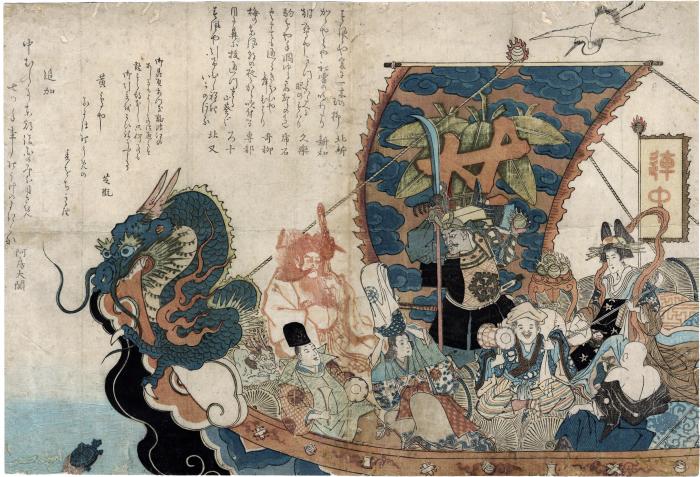Various figures aboard the Treasure Ship (Takarabune) which is generally reserved for the The Seven Gods of Good Fortune (Shichifukujin) - a mitate
1800s
Lyon Collection - a similar print representing the Seven Gods on a takarabune "Placing a picture of the seven Lucky Gods under one’s pillow on New Year`s Eve, is said to bring about the auspicious dream," Quote from Marije Jansen in 'Andon 104' from an article entitled 'Zuihitsu. New Year Rituals in surimono', from November 2017, page 53.
The first dream of the new year was referred to as the hatsuyume (初夢) and was believed to be an omen of the year to come.
****
This print has all the appearances of being a surimono: metallic printing, signed poems and a general relationship with the New Year celebrations. Normally the Treasure Ships carries the 7 Lucky Gods, but in this case some of them have been replaced by other prominent figures from Japanese history and literature. Shōki, printed all in red, is seen standing looking sternly into the distance. This is the Shōki who is meant as a talisman against smallpox. Seated toward the prow of the boat may be the figure of Ariwara no Narihira, one of Japan's great poets and lovers. He is holding a hand-drum. Behind him is a figure of an oni which appears to be about to pounce. In front of Narihira is a woman holding a basket on her head. She has draped a blue-and-white hand-towel over the high wicker handle, thus hinting at being the god of longevity with the incredibly tall skull. Hotei is there with his drum and bag of goodies, sitting atop his two bales of rice. Benten, the only goddess among the group of seven, is playing her instrument. In her hair is a fan which is decorated on the front with the red torii of a Shinto shrine, an indication of her sacredness. In the center stands Bishamon holding a flaming pearl of wisdom in one hand and a wicked looking naginata in the other. On his armor, covering his abdomen, is the sacred wheel of Buddhism. And in the lower right, seen from the back, is a monk with a shaved head. He, too, may represent one of the other great poets of Japan.
Above the sail is a white crane, while in front of the boat in the water is a long-tailed tortoise - both symbols of a long life.
surimono - 摺物 (genre)
Shōki (鍾馗), the Demon Queller (role)
Hotei (布袋) (author)
Ariwara Narihira (在原業平: from 825 to 880) (author)
mitate-e (見立て絵) (genre)
